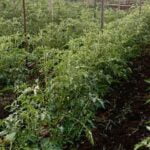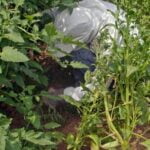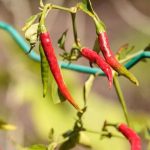Container vegetable gardening has become increasingly popular in Texas, offering a convenient and efficient way to grow fresh produce even with limited space. With the benefits of minimal maintenance and flexibility, container gardening is an attractive option for both beginner and experienced gardeners alike.
In this article, we will explore the specific focus of container vegetable gardening in Texas, providing valuable insights on selecting the right containers, essential soil and fertilizer recommendations, optimal sun exposure and watering strategies, pest and disease management, successful harvesting and maintenance practices, as well as showcasing success stories from local Texas gardeners. Join us as we delve into the world of container vegetable gardening in the Lone Star State.
The allure of container gardening has been steadily gaining traction throughout Texas as more individuals embrace its practicality and rewards. Whether you live in an apartment with a small balcony or have limited yard space in your suburban home, container gardening offers a creative solution to make the most of your available area while reaping the benefits of growing your own vegetables.
The ease of maintenance is particularly appealing for those who may not possess extensive gardening skills or have time for intensive care.
Furthermore, container vegetable gardening allows for better control over soil quality and drainage conditions compared to traditional gardens. This becomes especially important when considering the unique climate challenges that characterize various regions across Texas. By using suitable containers that accommodate these conditions, Texan gardeners can optimize their chances of successful harvests while ensuring their plants thrive.
In this comprehensive guide to container vegetable gardening in Texas, we will address various aspects vital to achieving fruitful results.
We will cover selecting the right containers for the Texan climate, provide soil and fertilizer recommendations tailored for success in containers, discuss ideal sun exposure and watering strategies, tackle common pest and disease challenges faced by Texan gardeners, offer tips on harvesting techniques and ongoing maintenance practices specific to container-grown vegetables, and even showcase real-life success stories from passionate local gardeners.
Embark on a journey of exploration and experience the joy of container vegetable gardening in Texas. The possibilities are vast, and the rewards are abundant. Let us inspire you as we navigate through the ins and outs of this popular gardening method, enabling you to make the most of your Texas growing season and create a bountiful oasis right at your doorstep.
Selecting the Right Containers for Texas Climate
When it comes to container gardening in Texas, selecting the right containers is essential for successful plant growth. The hot and often unpredictable climate requires containers that can withstand the intense heat and occasional extreme weather conditions. Here are some tips for choosing the appropriate containers for the Texas climate:
- Consider Clay Pots: Clay pots are a popular choice for container gardening in Texas due to their ability to insulate roots against the heat. These pots are porous and allow air movement through the soil, preventing waterlogged roots. However, they can be heavier and may require extra protection during freezing temperatures.
- Opt for Plastic Containers: Plastic containers are lightweight, durable, and better at retaining moisture compared to clay pots. They are also less expensive, making them a budget-friendly option for gardeners. Look for containers with UV protection to prevent excessive heat absorption.
- Explore Wooden Boxes: Wooden boxes offer excellent insulation against extreme temperatures but require proper drainage holes to avoid waterlogging. Cedar and redwood are popular choices as they naturally resist rotting and provide an attractive look to your garden.
Regardless of the material you choose, make sure your containers have sufficient drainage holes at the bottom to prevent root rot caused by excess water accumulation. Additionally, when selecting containers, consider their size based on your plants’ needs – larger plants require bigger containers with ample room for root growth.
In Texas’s hot climate, container gardening provides an ideal solution for growing vegetables without requiring extensive space or maintenance efforts of traditional gardening methods. By selecting suitable containers that withstand the challenging weather conditions and cater to your plants’ needs, you’ll be on your way to a thriving container vegetable garden in no time.
Essential Soil and Fertilizer Recommendations for Successful Container Vegetable Gardening in Texas
Importance of Soil Quality in Container Gardening
When it comes to successful container vegetable gardening in Texas, soil quality plays a crucial role. Since plants rely solely on the nutrients present in their containers, it is essential to provide them with a nutrient-rich and well-draining soil mix. The right soil composition ensures that vegetables receive the necessary nutrients for healthy growth, while also preventing problems such as waterlogging and root rot.
Ideal Soil Mix for Vegetables in Containers
To create an ideal soil mix for growing vegetables in containers, it is recommended to use a combination of potting soil, compost, and perlite or vermiculite. Potting soil provides a base that retains moisture while still allowing proper drainage. Compost adds organic matter and enriches the soil with nutrients. Perlite or vermiculite improves drainage and prevents compacting.
It’s important to maintain good drainage in container gardening since excess water can lead to root diseases. To ensure proper drainage, add a layer of gravel or broken pottery shards at the bottom of the container before filling it with the soil mix. This will help excess water to drain away from the roots.
Suitable Fertilizers for Container Vegetable Gardening
In addition to using a well-balanced soil mix, applying suitable fertilizers is crucial for successful container vegetable gardening in Texas. Since potted vegetables have limited access to nutrients compared to those grown directly in the ground, they require regular feeding throughout the growing season.
A balanced slow-release granular fertilizer specifically formulated for container gardening is highly recommended. These fertilizers release nutrients gradually over time, ensuring a steady supply of essential elements for plant growth. Be sure to carefully follow the instructions on the fertilizer packaging regarding application rates and frequency.
Additionally, foliar feeding can be beneficial for container-grown vegetables as it allows direct absorption of nutrients through their leaves. Use a water-soluble fertilizer suitable for vegetables and foliar feed the plants according to the recommended dosage.
By providing your container vegetable garden with nutrient-rich soil and appropriate fertilizers, you will give your plants the best chance of thriving in the Texas climate. The next section will focus on the vegetable varieties that are best-suited for container gardening in Texas.
The Best Vegetable Varieties for Container Gardening in Texas
Container gardening in Texas offers numerous benefits, including the ability to grow a wide variety of vegetables. When it comes to selecting the best vegetable varieties for container gardening in Texas, there are certain factors to consider. This section will highlight specific vegetable varieties that thrive in containers, with a focus on their compatibility with the Texas climate.
Heat-Tolerant Vegetables
One of the key considerations in container vegetable gardening in Texas is the ability to withstand the intense heat of summer. Some heat-tolerant vegetables that perform well in containers include tomatoes (determinate varieties like ‘Celebrity’ and ‘Patio’), peppers (such as ‘Jalapeno’ and ‘Cayenne’), and cucumbers (bush varieties like ‘Pick-a-Bushel’ and ‘Spacemaster’). These vegetables can handle the high temperatures and still produce abundant yields.
Compact Varieties
In container gardening, it’s essential to choose vegetable varieties that don’t take up too much space. Compact varieties that have smaller growth habits are ideal for containers. For example, bush beans like ‘Blue Lake’ or ‘Contender’, bush zucchini such as ‘Astia’, and dwarf varieties of lettuce like ‘Tom Thumb’ or ‘Little Gem’ are perfect choices for limited spaces without compromising yield.
Root Vegetables
Root vegetables can also be successfully grown in containers, provided you choose suitable varieties. For instance, radishes such as ‘Cherry Belle’ or ‘Early Scarlet Globe’, carrots like ‘Nantes’ or ‘Thumbelina’, and beets such as ‘Bulls Blood’ or ‘Red Ace’ all work well in containers due to their relatively shallow root systems.
Leafy Greens
Leafy greens are excellent choices for container gardening in Texas because they are quick-growing and don’t require a lot of space. Varieties like spinach (‘Baby-Leaf’ or ‘Tyee’), lettuce (‘Black-Seeded Simpson’ or ‘Salad Bowl’), and kale (such as ‘Red Russian’ or ‘Toscano’) can be continuously harvested and provide a fresh supply of nutritious greens.
It’s important to note that while these varieties have shown success in container gardening in Texas, individual experiences may vary. Factors such as microclimate, sunlight exposure, and the specific conditions of each garden can impact the performance of different vegetable varieties in containers. Gardeners are encouraged to experiment with different varieties and find what works best for their unique situations.
Optimal Sun Exposure and Watering Strategies for Container Vegetable Gardening in Texas
Sun Exposure for Container Vegetable Gardening
When it comes to container vegetable gardening in Texas, providing optimal sun exposure is crucial for the success of your plants. Most vegetables require at least six hours of direct sunlight per day, so it’s important to choose the right location for your containers. Place them in an area that receives ample sunlight, such as a south or southwest-facing balcony or patio.
However, keep in mind that the scorching Texas heat can be intense during summer months. To protect your plants from excessive heat stress, provide some afternoon shade by strategically placing the containers near buildings or using shade cloth. This will help prevent leaf scorch and maintain overall plant health.
Tips for Determining Sun Exposure:
- Observe the amount of sunlight your chosen location receives throughout the day
- Use a sun calculator app or device to measure the intensity of sunlight in specific areas
- If possible, place light-colored reflective materials around containers to maximize sunlight absorption
- Rotate containers periodically to ensure even sun exposure on all sides of the plants
Watering Strategies for Container Vegetable Gardening
In the hot and dry climate of Texas, proper watering techniques are essential to keep your container vegetables healthy and thriving. The key is to maintain consistent moisture levels without overwatering, which can lead to root rot and other issues.
Here are some watering strategies to follow:
- Check Soil Moisture: Regularly monitor the moisture content of the soil by sticking your finger about an inch deep into it. Water when the top inch feels dry but not completely parched.
- Deep Watering: When watering, make sure to water deeply until you see water draining out of the bottom of the container. This ensures that the entire root system gets sufficient water.
- Watering Schedule: In Texas, containers often require watering every day or every other day during hot summer months. Adjust the frequency based on how quickly the soil dries out.
- Avoid Overwatering: Remember that containers can dry out more quickly than ground beds, but they also don’t need to be continuously saturated. Avoid letting plants sit in standing water, as it can lead to root suffocation.
By providing optimal sun exposure and following proper watering strategies, you can ensure that your container vegetables in Texas receive the necessary conditions for healthy growth and abundant harvests.
Pest and Disease Management in Container Vegetable Gardening in Texas
Container vegetable gardening in Texas comes with its own set of challenges when it comes to pests and diseases. The warm climate and high humidity create an ideal environment for various pests and diseases to thrive. However, with proper management strategies, gardeners can minimize the impact of these common issues and ensure the health and productivity of their container vegetables.
One of the key steps in pest and disease management is prevention. It is important to start with healthy, disease-resistant plants and use clean planting materials. Additionally, practicing good sanitation by removing plant debris, sanitizing tools, and regularly cleaning containers can help prevent the buildup and spread of pests and diseases.
Early detection is also crucial in effectively managing pests and diseases. Regularly inspect your container vegetables for any signs of damage or distress. Look out for common pests such as aphids, caterpillars, and spider mites, as well as symptoms of diseases like powdery mildew, leaf spot, and root rot. Take prompt action if you observe any issues to prevent them from spreading further.
When it comes to treatment options, many gardeners prefer natural and organic remedies that are safe for both the plants and the environment. Some effective methods include using insecticidal soaps or oils to control pests like aphids or mealybugs, using neem oil for fungal infections like powdery mildew, or introducing beneficial insects like ladybugs or lacewings that feed on common garden pests.
To manage diseases caused by fungi or bacteria, you can also consider using organic sprays like copper-based fungicides or botanical extracts with antifungal properties. It is important to carefully follow the instructions on these products to ensure proper application and avoid any harm to your plants.
| Common Pests | Common Diseases |
|---|---|
| Aphids | Powdery mildew |
| Caterpillars | Leaf spot |
| Spider mites | Root rot |
Successful Harvesting and Maintenance Practices for Container Vegetable Gardening in Texas
Once your container vegetable garden in Texas is thriving with healthy plants, it is important to know the proper harvesting and maintenance practices to ensure continued success. Proper harvesting techniques, ongoing maintenance, and implementing best practices for extending the growing season are essential for a fruitful container garden.
When it comes to harvesting vegetables grown in containers, timing is crucial. Different vegetables have varying optimal harvest times, so it is important to familiarize yourself with each variety’s specific requirements. Generally, most vegetables should be harvested when they reach their peak ripeness or desired size.
For example, tomatoes should be picked when they turn fully red and become slightly soft to the touch. On the other hand, leafy greens like lettuce can be harvested continually by cutting off outer leaves as needed.
Regular maintenance is key to keeping your container vegetable garden healthy and productive. Pruning is an important practice that helps control the size and shape of plants while promoting better airflow and reducing disease risk. It involves removing dead or damaged foliage, trimming back excessive growth that may hinder sunlight penetration or block neighboring plants, and removing any suckers or side shoots that divert energy from fruit production.
In addition to pruning, trellising can be beneficial for certain vining vegetables like cucumbers or pole beans. By providing a support structure such as a trellis or stakes, you help these plants grow upward rather than sprawl across the container’s surface. This not only saves space but also makes it easier to harvest the fruits.
Nutrient supplementation through regular feeding is crucial for optimal plant growth in containers. While some nutrients may be present in the potting mix initially used during planting, additional fertilization will likely be necessary as plants consume those nutrients over time. Therefore, regularly monitoring plant health and applying suitable organic fertilizers or water-soluble balanced fertilizers according to label instructions becomes crucial for sustained growth and productivity.
Extending the growing season is an exciting possibility in container gardening. By providing protection during cooler months, you can enjoy fresh vegetables for an extended period. Consider using frost blankets or portable greenhouses to shield plants from cold temperatures and frost. In Texas, where temperatures can fluctuate greatly, these techniques can help maintain a conducive environment for your container vegetable garden.
By implementing proper harvesting and maintenance practices, you can ensure a bountiful container vegetable garden in Texas. Additionally, adopting methods to extend the growing season allows you to enjoy fresh produce all year round. The joy of container gardening in Texas lies not only in the process but also in savoring the fruits of your labor at each harvest.
Showcase Success Stories
Container vegetable gardening has gained significant popularity in Texas, with many gardeners sharing their successful experiences and tips. These success stories serve as an inspiration to those who are considering starting their own container vegetable gardens in the state.
One Texas gardener, Sarah Ramirez, recounts her experience with container gardening and how it has transformed her small urban backyard into a productive vegetable oasis. She initially turned to container gardening due to limited space and found that it offered far more advantages than she had anticipated. Not only does container gardening require less space than traditional in-ground gardens, but it also allows for easy maintenance and better control over soil quality and pests.
Another success story comes from Marcus Thompson, who resides in the scorching hot climate of West Texas. Thompson shares his journey of discovering heat-tolerant varieties that have thrived in his containers despite the harsh conditions. He emphasizes the importance of selecting vegetables that are well-suited for Texas summers, such as peppers, tomatoes, and okra. Thompson’s experience serves as a testament to how container gardening can adapt to challenging climates and still yield bountiful harvests.
These stories highlight the diverse range of successes that can be achieved through container vegetable gardening in Texas. From urban backyards to rural landscapes, gardeners across the state have found joy and satisfaction in cultivating their own fresh produce. Their experiences demonstrate not only the practical benefits of container gardening but also the sense of fulfillment that comes from growing one’s own food.
As you begin your journey into container vegetable gardening in Texas, take inspiration from these success stories and learn from experienced local gardeners who have faced similar challenges and triumphed over them. The wealth of knowledge gained from shared experiences can help you navigate the unique aspects of the Texas climate and optimize your growing practices. With dedication, enthusiasm, and a willingness to learn from others’ successes, your own container vegetable garden in Texas is sure to flourish.
Conclusion
In conclusion, container vegetable gardening in Texas offers an array of benefits and rewards. With its growing popularity, this gardening technique has captured the attention of many Texans due to its convenience and versatility. The limited space requirements and easy maintenance make it an ideal choice for urban dwellers or those with limited garden space. Additionally, container vegetable gardening allows individuals to have complete control over their plants’ growing conditions, resulting in successful harvests throughout the year.
When selecting containers for the Texas climate, it is essential to choose materials that can withstand the harsh weather conditions. Clay pots, plastic containers, and wooden boxes are popular options that provide durability and proper drainage. Proper soil preparation is crucial for thriving vegetables in containers. Incorporating organic matter and ensuring proper drainage will help maintain optimal soil quality.
Choosing the right vegetable varieties is vital for success in container gardening in Texas. Heat-tolerant vegetables that can withstand the scorching summer temperatures are recommended. Additionally, considering size, growth habit, and compatibility with container gardening will yield fruitful results.
Proper sun exposure and watering strategies are essential elements of successful container vegetable gardening in Texas. Determining the ideal amount of sunlight and shade required for various vegetables is crucial for their growth and productivity. Consistent moisture is necessary while avoiding overwatering due to the intense Texas heat.
Addressing pest and disease management early on is key to maintaining plant health in container gardens. Identifying common pests and diseases found in Texas gardens enables gardeners to take preventative measures to keep their plants thriving naturally.
Harvesting techniques specific to vegetables grown in containers should be followed to ensure maximum flavor and ongoing plant maintenance practices such as pruning, trellising, and nutrient supplementation contribute to a bountiful harvest.
Finally, embracing the joy of container vegetable gardening brings immeasurable rewards. By exploring the possibilities offered by this technique in the unique climate of Texas, readers can embark on a journey filled with fresh produce, personal satisfaction, and a stronger connection to nature. So why wait? Start your container vegetable gardening adventure today and reap the delicious and fulfilling benefits that await.
Frequently Asked Questions
What vegetables can you grow in pots in Texas?
In Texas, there are several vegetables that can be successfully grown in pots. Some popular choices include tomatoes, peppers (both sweet and hot varieties), eggplant, cucumbers, beans, lettuce, spinach, kale, and herbs like basil or parsley.
These vegetables adapt well to container gardening and can thrive in the warm climate of Texas. It’s important to choose suitable pot sizes for each plant and provide adequate sunlight and water according to their specific needs.
What vegetables grow well together in a container?
When it comes to growing vegetables together in a container, it’s important to consider their compatibility in terms of growth habits, nutrient requirements, and space utilization. Some combinations that work well together include tomatoes with basil or marigolds (which can deter pests), lettuce with radishes (since radishes grow quickly and occupy the space before lettuce needs it), carrots with onions or leeks (as carrots go deeper while onions stay more on the surface), and beans with corn or cucumbers (as they can provide climbing support for these vining plants).
Companion planting principles can help maximize space usage and enhance overall plant health.
What are the easiest vegetables to container garden?
If you’re new to container gardening or simply looking for easy vegetables to grow in pots, some great options include salad greens like lettuce or spinach. These leafy greens are quick-growing crops that don’t require a lot of space but offer a high yield if properly cared for. Herbs like mint or chives are also relatively simple to grow in containers as long as they have enough sunlight and regular watering.
Additionally, cherry tomatoes such as patio or determinate cultivars are excellent choices for small pots due to their compact size and prolific fruit production. Radishes are another favorite as they mature quickly and don’t need much room for roots to develop.

If you’re looking to get into vegetable gardening, or are just looking for some tips on how to make your current garden better, then you’ve come to the right place! My name is Ethel and I have been gardening for years. In this blog, I’m going to share with you some of my best tips on how to create a successful vegetable garden.





